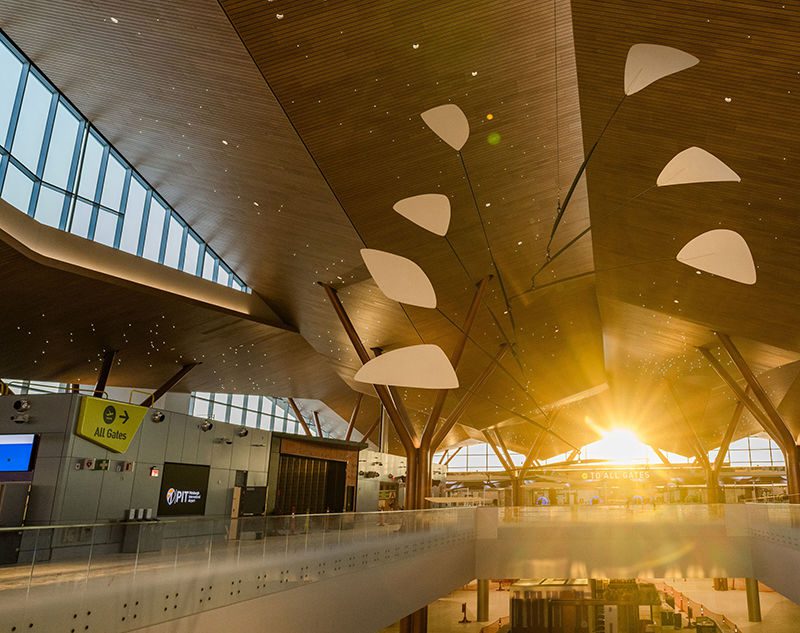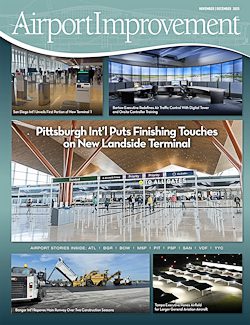For Pittsburgh International Airport (PIT) and its $1.7 billion Terminal Modernization Program, art is most certainly not an afterthought. Creativity was thoughtfully imbedded—from roadways leading to the airport to spaces throughout the brand new 811,000-square-foot terminal.
Keny Marshall, arts and culture manager at PIT, explains that the airport’s art program is an ongoing effort to create meaningful connections, reflect the region’s cultural heritage, serve as wayfinding elements and improve the overall experience for travelers. In 2018, an art master plan was developed to integrate art into every aspect of the terminal, including construction and design. It includes integrated artwork, rotating exhibits, and a schedule of live performances.
 “Art has always been a part of the airport and the way we affect the passenger experience,” Marshall says. The art master plan details how PIT can best integrate art into the terminal and all aspects of the Terminal Modernization Program.
“Art has always been a part of the airport and the way we affect the passenger experience,” Marshall says. The art master plan details how PIT can best integrate art into the terminal and all aspects of the Terminal Modernization Program.
The art program reflects Pittsburgh’s rich cultural heritage and its deep well of art and creativity, he adds. Works from 15 different artists can be found in 30 locations across the airport campus, and more than 80% of artists hail from the region. “It’s not just the airport that Pittsburgh deserves, but it’s the airport that Pittsburgh is presenting to the world,” Marshall explains.
Artists applied to both open calls and invitations, and their proposals were reviewed by selection panels that included Airport Authority staff, regional arts professionals and members of the project design team. Marshall and the Art in the Airport team before him identified specific areas where art could be added to improve the passenger experience.
“We try to be thoughtful in the way we integrate art and do it in a way that reflects our community, which is very creative,” Marshall says. “Early on the thought process was that the passenger experience is a key driver for not just the art program, but for how travelers interact with the airport.”
Art can provide moments of calm or delight and is “something to lessen the anxiety people feel when they travel,” Marshall comments. A master plan helps the art team be very intentional about placement of the art, he adds. Some commissions for the new terminal are intended to be viewed quickly as hurried travelers pass by, while others offer a “pause-and-wait moment.”
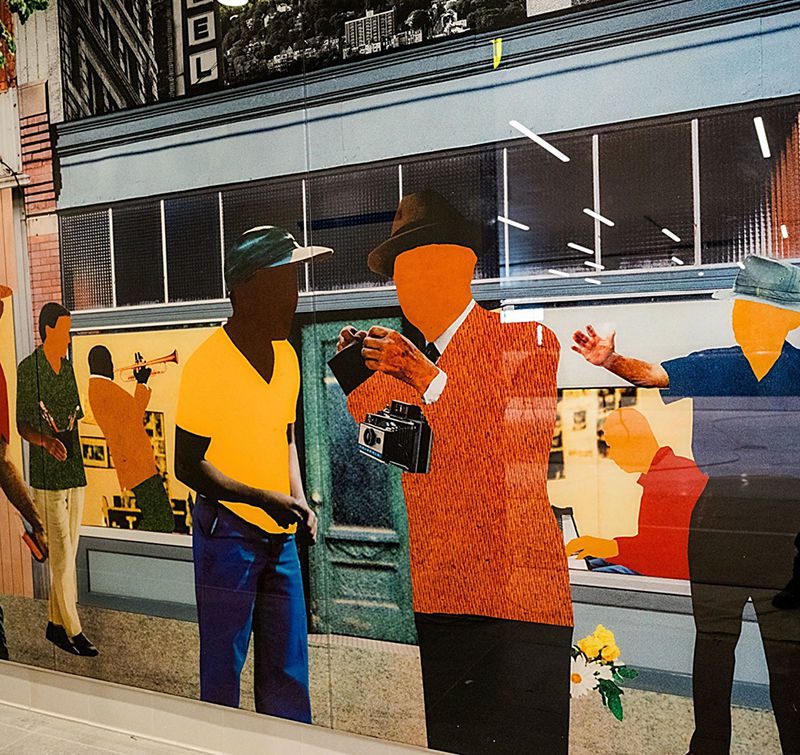
Looking Up From Here, by Njaimeh Njie
As guests approach the Western Pennsylvania airport, the work of Adam Kuby is featured on the façade of the multi-modal complex and the retaining walls for the road and bridge that carry vehicles to the new terminal. Cross Currents is comprised of pre-cast panels with 21 unique patterns grooved into approximately 50,000 square feet of mechanically stabilized concrete and the parking garage spandrels. The work creates a canvas out of a normally utilitarian plane and ties it into the landscape, Marshall notes.
Kuby worked closely with the art team, bridge engineers and architects on the project, creating several mockups and testing the concrete.
Highlighting the pedestrian walkways around the multi-modal complex is Patrick Marold’s Open Columns. The series of three 20- to 40-foot-tall steel cylinders is intended to evoke the smokestacks from Pittsburgh’s steelmaking days. The columns are hollow and feature a polished metal interior that catches the sunlight and presents the reflected sky as a contrast to their oxidized exterior surface.
Pittsburgh is a kinetic mobile by famed artist Alexander Calder that adds another dose of nostalgia to the new terminal. It was originally installed in the rotunda of Greater Pittsburgh Airport in 1959 and also spent time at the Carnegie Museum of Art before moving to PIT in 1992. The artwork was in storage for two years in preparation for its recent move to the new terminal.
Made of black steel rods and white aluminum paddles, Pittsburgh is balanced so its hanging elements move with just the slightest breeze. Iconic pieces like the Alexander Calder mobile are used for wayfinding and visual impact, and help reinforce the airport’s identity, says Marshall.
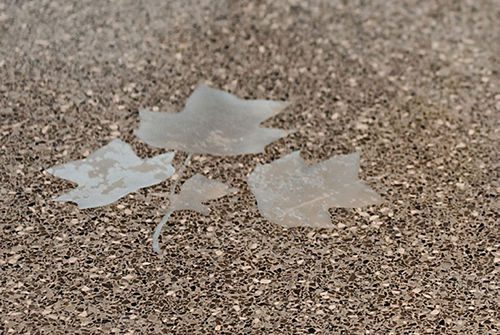
Above: Forrest Floor, by Clayton Merrell
Below: Jason Boone of Urban Tree created enclosures for Flight Information Displays
out of reclaimed wood.
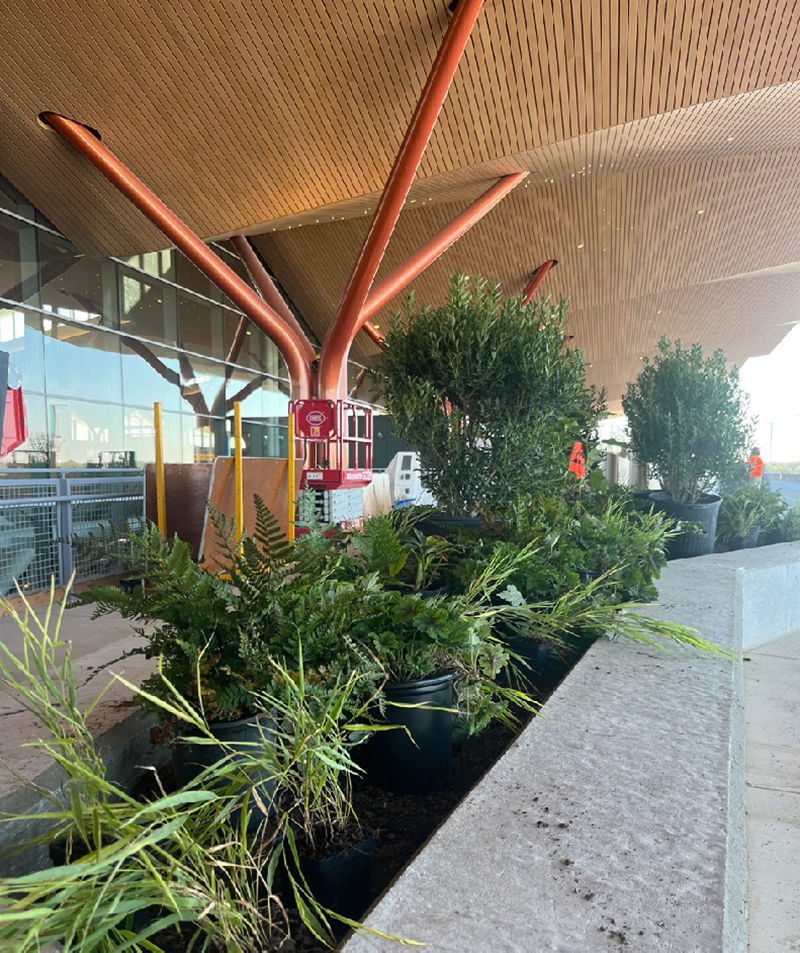
Large glass art walls adorn restroom entrances, providing intuitive wayfinding support. “All of these spaces talk to each other,” Marshall says. Guests can easily identify restrooms from a distance, because they have passed other restrooms with the same finish and artwork elsewhere in the terminal.
Because installations occurred in conjunction with construction, artists received the same safety and project training as contractors. “There is a place for art to come in after a building is constructed, but there is a sweet spot, especially with the large-scale integrated commissions, to start talking about it and working on it early,” says Marshall.
To ensure cohesiveness with the new terminal, PIT’s existing airside terminal received an update to its finishes and artwork. For example, the terrazzo floor designed by local artist Clayton Merrell was expanded to create a visual connection to the new building.

